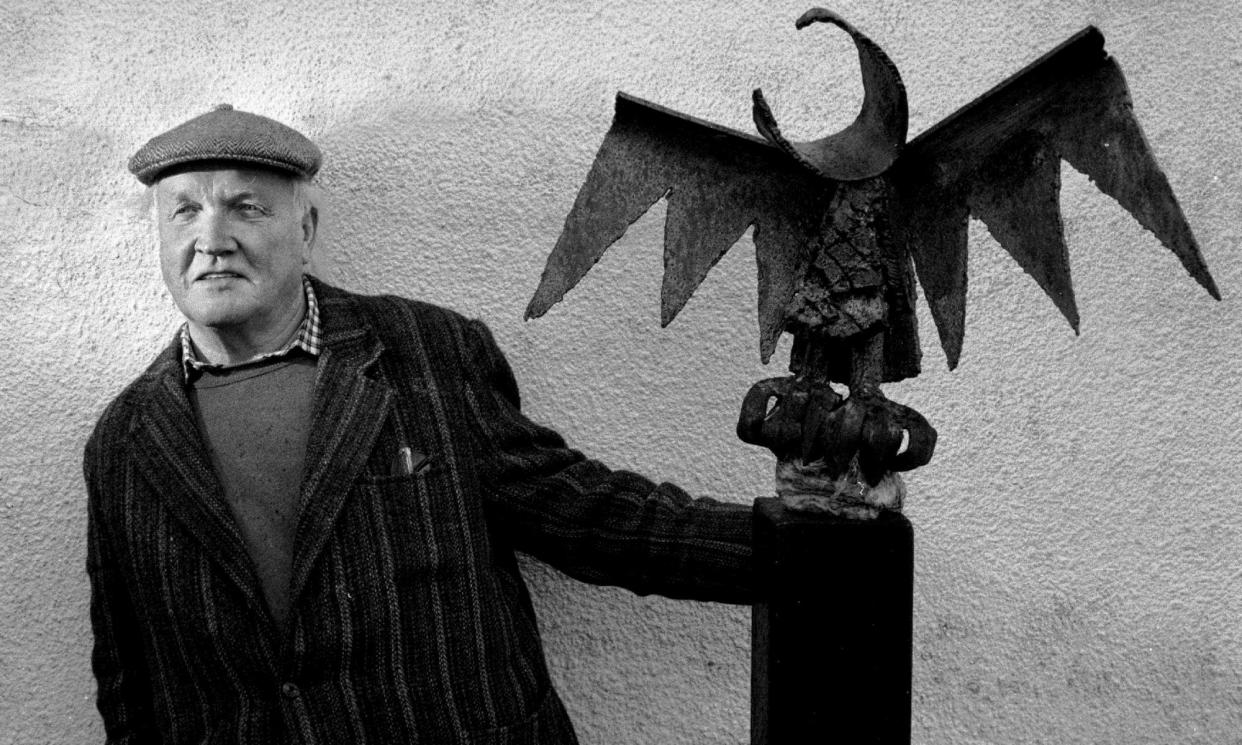‘George’s machines’: museum devoted to George Wyllie opens on the Clyde

He was the artist who sailed a paper boat past New York, set a straw locomotive on fire over the Clyde, and inserted a question mark into the word sculpture.
George Wyllie, a prolific, self-taught “social sculptor” who worked with steel, stone, wood and paper, used humour to make deeply serious criticisms of the climate crisis, capitalism and Britain’s industrial decline.
More than a decade after his death in 2012, Wyllie has been given the singular accolade of a museum built to show his work, bringing him alongside a handful of UK sculptors with dedicated spaces such as Henry Moore and Barbara Hepworth.
Frequently seen in his uniform of flat cap and overalls, Wyllie became famous for sailing his seaworthy paper boat down the Clyde in 1989, then the Thames – taking it past the Houses of Parliament and to New York’s World Financial Center on the Hudson in 1990. It was his homage to Glasgow’s lost shipbuilding skills.
In 1987, he made from straw a life-size replica of the locomotives built in their hundreds by Glasgow’s engineering firms. It was lifted into the air from the Finnieston crane on the Clyde, originally used to heft those engines into Clydeside-built ships, before he burned it at one of those engineering works. Inside the steel frame exposed by the fire was a single question mark.
“He was a wonderful mixture of metaphysical thinking about the state of the planet [but] at the same time playing his ukulele,” said Bill Paterson, the Glaswegian actor, who was among those to collaborate with Wyllie.
Called the Wyllieum, the museum opens later this month on the banks of the Clyde in a new building in Greenock that it will share with the town’s cruise liner terminal. It is close to where Wyllie lived with his wife, Daphne, in Gourock, welding sculptures in the basement.
When cruise ship passengers disembark, they will see the inaugural exhibition of his spires, delicately balanced constructions often made from salvaged scrap steel, which Wyllie placed outdoors to be caught by the breeze.
His work was heavily influenced by his friends, the German conceptual artist Joseph Beuys and the US kinetic sculptor George Rickey, as well as the arte povera, or “poor art”, movement of the 1960s. Sara Barker, a sculptor and co-curator of the exhibition, said his spires were “nomadic pieces you could erect anywhere”.
Wyllie was prophetic, said Will Cooper, the museum’s director. He “made work about colonialism by white nations, when very few white Europeans were making that work; very few people were making work about what we’re doing to the environment. It has taken 40 years for the world to catch up.”
Paterson, who narrates the BBC series The Repair Shop, took part in a hit run of Wyllie’s sculpture-based satirical play on Thatcherite greed, A Day Down a Goldmine, at the Edinburgh fringe, where it won a fringe first, and at the ICA in London in 1985.
Paterson said: “I just love the idea that the first thing that 90% of these tourists see as they step off the boat in Scotland will be a George Wyllie sculpture; before they get to Edinburgh castle or Loch Ness, they’re going to see George’s machines.”
The site is close to the Customs House building where the artist spent much of his career as a customs officer – a decision the museum’s backers says helps to root the collection in the place where he lived and worked.
Cooper said local people had come knocking on the double-height wooden doors of the museum before it opened to offer their stories about Wyllie and his generosity, often giving them pieces by him for free.
Some donated their items, including a super-sized white vinyl model of a “wally dug” figurine. With a speaker concealed in its feet, it was one of two stereo radio speakers Wyllie designed, and now features in the museum’s collection.
Louise Wyllie, the sculptor’s elder daughter, said the Clyde “was the lifeblood that ran through his veins, and without it he couldn’t function … He ate his dinner at the Gourock Continental cafe every evening for years and held court with anyone, both locals and visitors alike, hoping to influence their views on how they might make the world a safer and better place.
“Not many suburban houses had a large stainless steel eagle perched outside the front door. The neighbours were bemused, as was the shipping on the Clyde that responded to his welding flashes with hoots and horns as they passed up the river.”
* The Wyllieum opens on 26 April, at Greenock Ocean Terminal, Custom House Way, Greenock PA15 1EG


